Aguascalientes
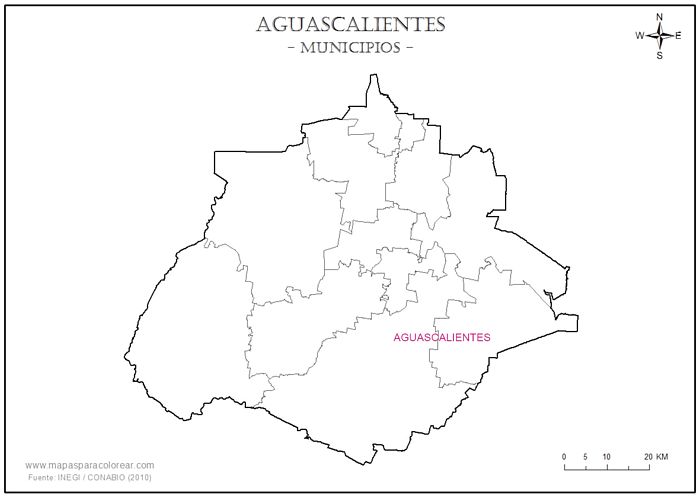
When Villa’s División del Norte occupied Aguascalientes in April 1915 it was decided to replace the cartones for copper coins of 5c, 10c and 20c. At a meeting between Villa, the governor General Benito Díaz and his Secretario del Gobierno, Antonio Dovalí, they decided to ask José R. Acosta, superintendent of the Workshops of the Ferrocarriles Nacionales whether they had the necessary elements. Acosta said he only needed to receive instructions from the Superintendent of Motive Power and Machinery, Pedro C. Morales, and having done so, gave orders to Arnulfo Aranda, in charge of the Tool Room (Departamento de Cuarto de Herramientas), to modify a machine to make a die-cutting machine.
Then they proceeded to make a machine for laminating and an apparatus for edging the coins. They produced dies for the 5c, 10c and 20c coins, but had difficuly in engraving the 20c and sent to Zacatecas for a die. Ricardo Aguilar was the one who made the dies.
Striking commenced around Easter 1915 and continued until Obregón’s forces attacked and drove ot Villa’s forces on 10 July. 45,520 pieces were minted, namely 20,500 of five centavos. 12,100 ten centavos and 12,650 of 20 centavos, though no 10c pieces are known. 1- and 2-centavo test dies were made, as well as 6 20-centavos silver samplesSaul Renato Garibay, Historia Numismática de Aguascalientes, .
The coins form an odd series of copper minors in four denominations with their silver counterparts that were probably meant to be presentation pieces.
Some copper coins are cast versions of die-struck coins, suggesting these were circulating counterfeits. Garza, however, claimed he had information that a Villa general ordered the cast 20 centavos. It is not clear if Garza meant all cast 20 centavos or only a particular variety. Guthrie1976 interpreted Garza’s statement as referring to the convex wing/flat 20 version of the 20 centavos. Cast silver coins are suspicious and are viewed as modern counterfeits.
One centavo
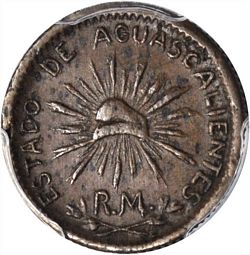
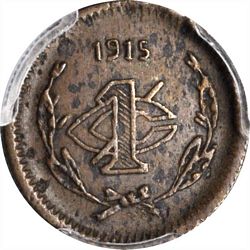
KM-601 Aguascalientes 1c small date, reeded edge (Stack’s Bowers NYINC Auction, 15 January 2019, lot 43692)
This issue was struck using two date/denomination dies and one Liberty cap die. The varieties are known as the small date (struck first) and large date. Both varieties, as well as the other denominations, are known in reeded and plain edges. The reeded-edge varieties are often struck up better than the plain-edge coins. This is due to the physics of the strike (instead of expanding, the coin is constrained by the collar and more metal is forced into the die design).
GarzaGarza, 1932 reported that about 50 sets of silver coins were struck as presentation pieces. The one centavo silver is the most common of these silver strikes. The silver large-date variety appears to be somewhat more common than the small-date variety.
Joe Flores estimated that eight to twn of the large date silver strikes exist. It is difficult to imagine that 50 sets of the silver coins were produced, as the higher denominations are so rare. It seems more probable that 50 one-centavo coins were produced, with considerably fewer higher denomination coins struck.
Two centavos

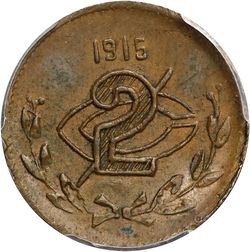
KM-602.2 Aguascalientes 2c square-front 2 (Stack’s Bowers Auction, 1 November 2023, lot 72169)
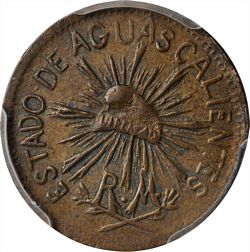

KM-602.1 Aguascalientes 2c curved-front 2, plain edge (Stack’s Bowers Auction, 23 October 2019, lot 72608)
Once again, there are two date/denomination dies and one Liberty cap die. The varieties are the square-front two and the curved-front two. The square front two was struck first. The two centavos is the scarcest of the four Aguascalientes denominations, and the curved-front two the more rare of the two centavos.
As in the one centavo, there is a two centavos struck in silver.
Five centavos
The five-centavo series has two major designs – the numeral five with three different dies and the cap-and-rays five, in combination with three eagle dies.
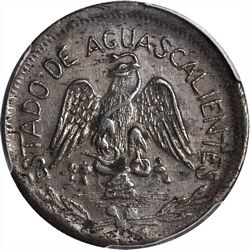
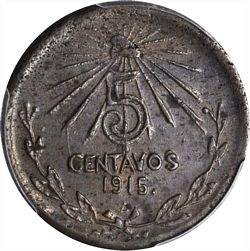
KM-603 Aguascalientes 5c (Stack’s Bowers NYINC Auction, 15 January 2019, lot 43694)
The initial striking of the numeral five series appears to be the plain, or unshaded, five. The design is similar to the Chihuahua five centavos. It was perhaps rejected for this reason, as the Conventionists in Aguascalientes were supposed to be independent of Villa. This is considered a pattern strike and is a rare coin. The eagle die was used in the following coin, the vertical-shaded five.
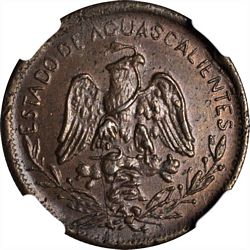
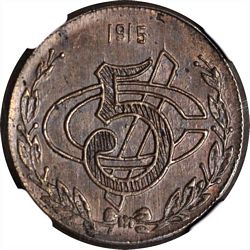
KM-604.1 Aguascalientes 5c vertical/diagonally shaded 5, reeded edge (Stack’s Bowers NYINC Auction, 15 January 2019, lot 43693)
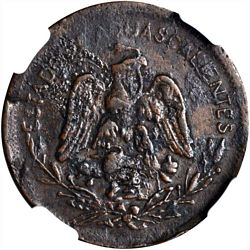
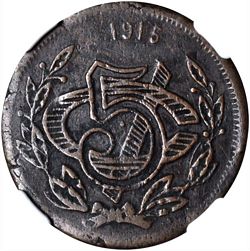
KM-unl Aguascalientes 5c unshaded 5, horizontal shading in centavo symbol, plain edge (Stack’s Bowers Auction, 4 August 2017, lot 21279)
The other numeral five dies are the vertical-shaded five and the horizontal-shaded five. These coins are the business strikes of the numeral five series.
A vertical-shaded five with reeded edge coin is known as a cast issue. The horizontal-shaded five, with reeded edge is known as a silver strike.
Guthrie concludes the five-centavo series with the cap-and-rays design due to its similarity in design to the following 20-centavo coins.
Twenty centavos
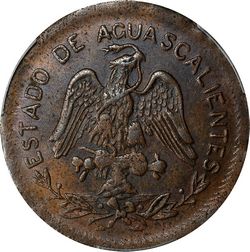
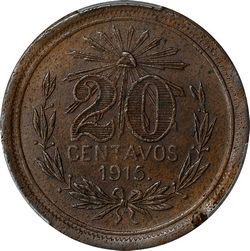
KM-606 Aguascalientes 20c (Stack’s Bowers Auction, 12 September 2023, lot 73390)
The varieties are the convex wing/curved 20, followed by the concave wing/curved 20 and concluding with the concave wing/flat 20.
The three basic strikes exist in cast copper versions. As noted earlier, it is not clear if this is an actual authorised issue by a villa general, a circulating counterfeit (as suggested by Howland Wood) or a combination of the two.
Two varieties of 20-centavo silver strikes are known. There is a convex wing/curved 20 reeded edge strike, and an extremely thick, well struck piedfort of the concave wing/flat 20 with plain edge.
